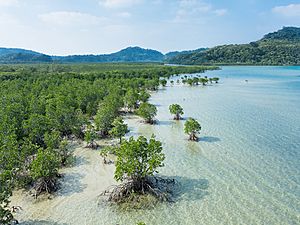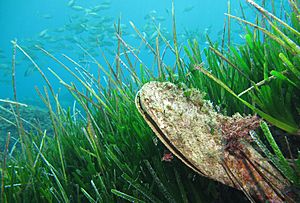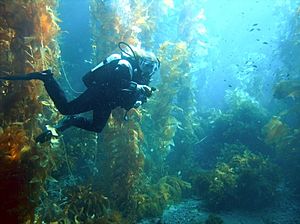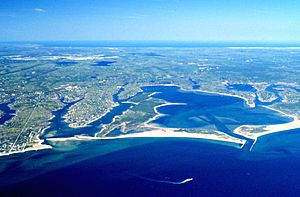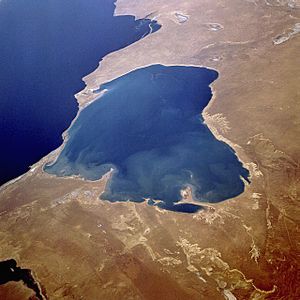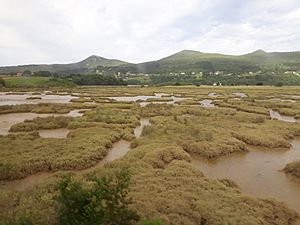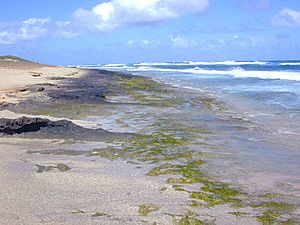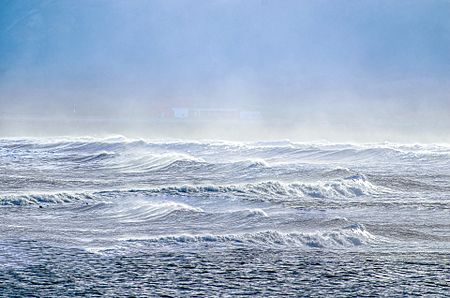Marine ecosystem facts for kids

Marine ecosystems are the largest aquatic ecosystems on Earth. They are found in salty water, unlike freshwater ecosystems, which have less salt. These amazing systems cover more than 70% of Earth's surface. They hold over 97% of all the water on our planet and make up 90% of the habitable space on Earth!
Ocean water usually has about 35 parts of salt per thousand parts of water. But the exact saltiness can change in different marine ecosystems. We can divide marine ecosystems into many zones based on how deep the water is and what the shoreline looks like.
For example, the oceanic zone is the huge open part of the ocean where big animals like whales, sharks, and tuna live. The benthic zone is the bottom of the ocean, where many invertebrates (animals without backbones) live. The intertidal zone is the area between high and low tides, which gets covered and uncovered by water every day.
Other areas near the shore include mudflats, seagrass meadows, mangroves, rocky intertidal systems, salt marshes, coral reefs, and lagoons. In the deep ocean, you might find hydrothermal vents. Here, special chemosynthetic sulfur bacteria create food, forming the base of the food web in a place where sunlight can't reach.
Marine ecosystems are defined by the living things that call them home and by their physical surroundings. Some organisms you might find include brown algae, dinoflagellates, corals, cephalopods (like octopuses), echinoderms (like starfish), and sharks.
These ecosystems are super important! They provide many services to us, like food and jobs for people all over the world. However, human activities and pollution are big threats to these important places. Problems include taking too many resources (like overfishing), ocean pollution, climate change, and building too much on coastal areas.
Also, the ocean absorbs a lot of the carbon dioxide that causes global warming and much of the heat that gets trapped. This changes the ocean chemistry through processes like ocean acidification, which harms marine ecosystems. Because marine ecosystems are so important and face so many threats, countries around the world have made "Life below water" a priority. This is part of Sustainable Development Goal 14, which aims to "Conserve and sustainably use the oceans, seas and marine resources for sustainable development."
Contents
Coastal ecosystems
Coastal ecosystems are getting a lot of attention because of the threats they face. Sustainable Development Goal 14, called "Life Below Water," sets goals for countries to protect these ecosystems. It also encourages sustainable ways for coastal communities to live and work. The United Nations has even declared 2021-2030 the UN Decade on Ecosystem Restoration. This means they want to focus on restoring damaged ecosystems, including coastal ones.
Coral reefs
Coral reefs are some of the most famous marine ecosystems. The biggest one is the Great Barrier Reef in Australia. These reefs are made up of many different types of coral living together in large groups. Corals form special partnerships with other organisms around them, helping each other survive.
Mangroves
Mangroves are trees or shrubs that grow in tropical or subtropical areas, usually near coastlines where the soil has very little oxygen. They create a very busy and complex ecosystem that connects the land and the sea. Mangroves are often grouped together because they share similar features, even if they aren't closely related.
Because they live so close to the coast, mangroves have developed special ways to survive in salty, low-oxygen water. For example, they can get rid of extra salt and their roots can breathe air. You can often spot mangroves by their thick, tangled roots. These roots help protect the coast by slowing down erosion from storms, currents, waves, and tides. Mangrove ecosystems also provide a lot of food for many different species. They are also excellent at sucking up carbon dioxide from the air. It's estimated that mangroves around the world store 34 million metric tons of carbon each year!
Seagrass meadows
Seagrasses form thick underwater "meadows" that are among the most productive ecosystems on Earth. They provide homes and food for many different kinds of marine life, much like coral reefs do. This includes small animals like shrimp and crabs, fish like cod, and even marine mammals and birds.
Seagrass meadows are safe places for endangered animals such as seahorses, turtles, and dugongs. They also act as nurseries for young shrimp, scallops, and many fish that humans catch for food. These meadows help protect coasts from storms because their leaves absorb energy from waves before they hit the shore. They keep coastal waters clean by soaking up bacteria and nutrients. Plus, they help slow down climate change by storing carbon dioxide in the ocean floor's sediment.
Sadly, seagrass meadows are being harmed by human activities. Pollution from land, fishing boats dragging nets across the meadows, and too much fishing (which throws the ecosystem out of balance) are all problems. Seagrass meadows are currently being destroyed at a rate of about two football fields every hour.
Kelp forests
Kelp forests are found in temperate and polar coastal oceans around the world. In 2007, they were even found in tropical waters near Ecuador.
Kelp forests are made of large brown algae called macroalgae. They create a special home for many marine organisms. Scientists study them to understand how ecosystems work. Kelp forests can even change ocean patterns near the coast and provide many ecosystem services (benefits to humans).
However, human actions have often damaged kelp forests. A big concern is overfishing near the coast. When too many fish are caught, it can remove the animals that usually keep plant-eating creatures (herbivores) in check. This can lead to too much grazing on kelp and other algae, turning a lively kelp forest into a barren area with few species.
Because of overfishing and climate change, kelp forests have almost disappeared in many vulnerable places, like Tasmania's east coast and Northern California. Creating marine protected areas is one way to help. These areas can limit fishing and protect the ecosystem from other environmental stresses.
Estuaries
Estuaries are places where salty ocean water mixes with fresh water from rivers or streams. This creates a unique type of water called "brackish" water. The animals and plants found here are special because they can live in this mix of fresh and salt water.
Other types of estuaries exist too. For example, in the Great Lakes, river water mixes with lake water to create freshwater estuaries. Estuaries are very productive ecosystems. Many humans and animals depend on them for different activities. In fact, 22 of the 32 largest cities in the world are located on estuaries! This is because estuaries offer many environmental and economic benefits. They provide important homes for many species and are economic centers for coastal communities.
Estuaries also offer essential ecosystem services. These include filtering water, protecting habitats, controlling erosion, regulating gases, and cycling nutrients. They even provide opportunities for education, recreation, and tourism.
Lagoons
Lagoons are areas of water that are separated from larger bodies of water by natural barriers, like coral reefs or sandbars. There are two main types: coastal lagoons and oceanic/atoll lagoons.
A coastal lagoon is simply a body of water separated from the ocean by a barrier. An atoll lagoon is a circular coral reef or several coral islands that surround a lagoon. Atoll lagoons are often much deeper than coastal lagoons.
Most lagoons are very shallow. This means their water is greatly affected by changes in rainfall, evaporation, and wind. Because of this, the saltiness and temperature in lagoons can vary a lot. The water can range from fresh to very salty (hypersaline).
Lagoons can be found on coasts all over the world, on every continent except Antarctica. They are incredibly diverse habitats, home to many species including birds, fish, crabs, and plankton. Lagoons are also important for the economy. They provide many ecosystem services like fisheries, nutrient cycling, flood protection, and water filtration. They even support human traditions.
Salt marsh
Salt marshes are transition zones between the ocean and the land, where fresh and salt water mix. The soil in these marshes is often made of mud and a layer of decomposing plant material called peat. Peat is usually waterlogged and full of roots, which often leads to low oxygen levels. These low oxygen conditions cause certain bacteria to grow, which gives salt marshes their well-known sulfur smell.
Salt marshes exist around the world and are vital for healthy ecosystems and economies. They are very productive ecosystems. They provide essential services for more than 75% of fish species that humans catch. They also protect shorelines from erosion and flooding.
Salt marshes can generally be divided into three parts: the high marsh, the low marsh, and the upland border. The low marsh is closest to the ocean and is flooded by almost every tide, except at low tide. The high marsh is between the low marsh and the upland border. It usually only gets flooded during higher-than-usual tides. The upland border is the freshwater edge of the marsh. It's usually a bit higher than the high marsh and only gets flooded during extreme weather. This area experiences much less waterlogging and salt stress than other parts of the marsh.
Intertidal zones
Intertidal zones are the areas of the coast that are exposed to the air during low tide and covered by salty water during high tide. There are four main physical parts of the intertidal zone, each with its own unique features and wildlife.
These parts are the Spray zone, High intertidal zone, Middle Intertidal zone, and Low intertidal zone. The Spray zone is a damp area that is usually only reached by ocean spray and gets submerged only during very high tides or storms. The High intertidal zone is covered at high tide but stays dry for long periods between high tides. Because conditions can change so much here, it's home to tough wildlife like barnacles, marine snails, mussels, and hermit crabs, which can handle these changes.
Tides flow over the Middle intertidal zone twice a day, and this zone has a greater variety of wildlife. The Low intertidal zone is almost always underwater, except during the very lowest tides. Life is much more abundant here because the water provides constant protection.
Ocean surface
Organisms that live freely at the ocean's surface are called neuston. This group includes important organisms like the golden seaweed Sargassum, which forms the famous Sargasso Sea. You can also find floating barnacles, marine snails, nudibranchs, and cnidarians (like jellyfish). Many fish species that are important for both the environment and the economy either live as neuston or depend on them.
Life at the surface isn't spread out evenly. The ocean's surface has unique neustonic communities and regions found only at certain latitudes and in specific ocean basins. But the surface is also directly affected by climate change and pollution. Life on the ocean's surface connects different worlds. From shallow waters to the deep sea, and from the open ocean to rivers and lakes, many land and sea species rely on the surface ecosystem and its organisms.
The ocean's surface acts like a skin between the air above and the water below. It's home to an ecosystem unique to this environment. This sun-drenched habitat is roughly one meter deep, as nearly half of harmful UV-B rays are blocked within this first meter. Organisms here must deal with waves and special chemical and physical conditions. Many species use the surface, from various fish and cetaceans (like dolphins) to species that ride on ocean debris (called rafters).
Most importantly, the surface is home to a unique community of free-living organisms called neuston (from a Greek word meaning "to swim" and "to float"). Even though the ocean's surface is diverse and important for connecting different habitats, and despite the risks it faces, we still don't know a lot about neustonic life.
A stream of tiny airborne organisms circles the planet above weather systems but below airplane routes. Some of these tiny travelers are picked up from dust storms on land. However, most come from marine microorganisms in sea spray. In 2018, scientists reported that hundreds of millions of viruses and tens of millions of bacteria are deposited every day on every square meter around the planet.
Deep sea and sea floor
The deep sea holds up to 95% of the space where living organisms can be found. When you combine the deep sea with the sea floor (also called the benthic zone), these two areas have not yet been fully explored. Scientists are still discovering and documenting the organisms that live there.
Ecosystem services
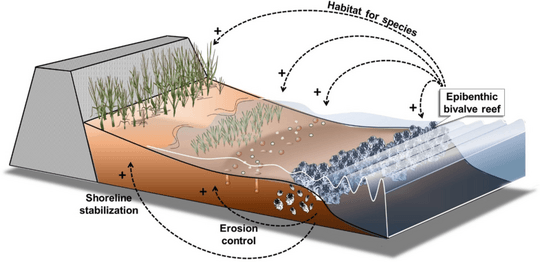
Marine ecosystems not only benefit the natural world but also provide many social, economic, and biological ecosystem services to humans. Open ocean (pelagic) marine systems help regulate the global climate and contribute to the water cycle. They also maintain biodiversity, provide food and energy resources, and create opportunities for recreation and tourism.
Economically, marine systems support billions of dollars worth of fishing, aquaculture (farming seafood), offshore oil and gas, and trade and shipping. These services fall into different groups, including supporting services (like nutrient cycling), provisioning services (like food), regulating services (like climate control), and cultural services (like recreation).
Threats
Human exploitation and development
Coastal marine ecosystems are facing increasing pressure from growing populations. Nearly 40% of people in the world live within 100 kilometers (about 62 miles) of the coast. Humans often gather near coastal habitats to benefit from the services these ecosystems provide. For example, coastal fishing from mangroves and coral reefs is estimated to be worth at least $34 billion each year.
However, many of these habitats are not well protected, or not protected at all. The area covered by mangroves worldwide has shrunk by more than one-third since 1950. Also, 60% of the world's coral reefs are now directly threatened. Human development, aquaculture (fish farming), and industrialization often lead to the destruction, replacement, or damage of coastal habitats.
Moving further offshore, open ocean (pelagic) marine systems are directly threatened by overfishing. The amount of fish caught globally reached its highest point in the late 1980s. Now, it is declining, even though more effort is being put into fishing. The total amount of fish (biomass) and the average trophic level of caught fish are decreasing. This leads to a decline in marine biodiversity.
Specifically, local extinctions have caused declines in large, long-lived, slow-growing species, and those that live in small areas. Losing biodiversity can lead to a decrease in the ecosystem services these areas provide. A long-term study showed that the catch of sharks off the Australian coast declined by 74–92% from the 1960s to the 2010s. Such losses of biodiversity affect not only the species themselves but also humans. They can also contribute to climate change around the globe. The National Oceanic and Atmospheric Administration (NOAA) says that managing and protecting marine ecosystems is vital for saving biodiversity as Earth's climate changes rapidly.
Pollution
Ocean pollution is a big problem. It includes all the harmful materials that humans put into the ocean. This can be anything from plastic bags and bottles to chemicals and oil spills. Pollution harms marine life, damages habitats, and can even affect human health.
Invasive species
- Global aquarium trade (when people buy and sell marine animals for aquariums)
- Ballast water transport (ships taking on water in one place and releasing it in another, carrying organisms with it)
- Aquaculture (fish farming, which can sometimes introduce non-native species)
Climate change
- Warming temperatures (the ocean getting hotter)
- Increased frequency/intensity of storms (more frequent and stronger storms)
- Ocean acidification (the ocean becoming more acidic due to absorbing carbon dioxide)
Images for kids
See also
 In Spanish: Ecosistema marino para niños
In Spanish: Ecosistema marino para niños




